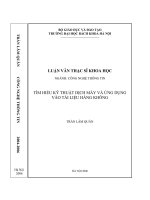Tài liệu Đề tài Luận văn Cao học công nghệ thông tin năm học 2007-2008 tại ĐHBK TP HCM docx
Bạn đang xem bản rút gọn của tài liệu. Xem và tải ngay bản đầy đủ của tài liệu tại đây (303.02 KB, 15 trang )
tài Lun vn Cao hc CNTT nm hc 2007-2008 ti HBK TP HCM
GVHD: TS. Nguyn Ha Phùng
1:
Software Verification là k thut xác đnh xem mt phn mm tha mãn các yêu cu thit k. K thut
này đòi hi xác đnh mt phng pháp mô t các yêu cu thit k và mt c ch suy din đ thc hin
quá trình chng minh.
Yêu cu: Sinh viên cn có kin thc c bn v logic toán
Giai đon làm đ cng:
- Tìm hiu lý thuyt v software verification
- Tìm hiu mt s phng pháp mô t hin có
- Tìm hiu các c ch suy din hin có
- Xác đnh phm vi nghiên cu
Giai đon làm lun vn:
- Phát trin mt mô hình thích hp
- Hin thc chng trình
- Th nghim
2:
Plagiarism Detection là k thut phát hin sao cp phn mm. K thut đánh giá kh nng trùng khp
c
a hai phn mm t đó d đoán kh nng sao cp.
Giai đon làm đ cng:
- Tìm hiu v các k thut Plagiarism Detection hin có
- Tìm hiu mt s phn mm hin có
- Xác đnh phm vi nghiên cu
Giai đon làm lun vn:
- Phát trin mt mô hình thích hp
- Hin thc chng trình
- Th nghim
3:
Tìm hiu mô hình vi x lý h ARM và phát trin trình biên dch cho ARM da trên gcc.
Giai đon làm đ cng:
- Tìm hiu v đc tính ca vi x lý h ARM
- Tìm hiu c ch sinh trình biên dch ca gcc
- Tìm hiu các đc t hin có ca ARM trên gcc
- Xác đnh phm vi nghiên cu
Giai đon làm lun vn:
- xut mt gii pháp thích hp
- Hin thc ch
ng trình
- Th nghim
GVHD: TS. Qun Thành Th
1: Xây dng mt chng trình dy hc lái xe thông minh da trên lut.
Sinh viên đng ký: Lê Anh V
2: Xây dng mt kin trúc cp nht đng ni dung trang Web theo hng tip cn s dng các dch
v Web có ng ngha thông qua các mô t bng ngôn ng t nhiên
Sinh viên đng ký: Nguyn Bo Toàn
3: Xây dng chng trình phát hin các mu qung cáo đc lp li nhiu l
n trong các chng
trình MP3 podcasting
ng hng dn: Tin s Nguyn Minh Nht (i hc Công ngh Nanyang, Singapore)
Sinh viên đng ký: Phan Thanh Cao
GVHD: PGS. TS. Cao Hoàng Tr
Hng nghiên cu: Web ng ngha
1. Gom cm m tài liu theo thc th có tên và t khoá
Tham kho:
Cao, T.H. & Do, H.T. & Hong, D.T. & Quan, T.T. (2008), Fuzzy Named Entity-Based
Document Clustering. In Proc. of the 17th IEEE International Conference on Fuzzy Systems.
2. Nhn din quan h gia các thc th có tên trên vn bn
Tham kho:
Cao Duy Trng (2008). Dch câu truy vn ting Anh sang đ th khái nim: cách tip cn ít ph thuc
cú pháp. Lun vn Cao hc, Khoa KH&KT Máy tính, HBK TP.HCM.
3. Dch câu truy vn ting Anh có liên t lun lý, tính t, và lng t sang đ th khái nim
Tham kho:
Cao Duy Trng (2008). Dch câu truy vn ting Anh sang đ th khái nim: cách tip cn ít ph thuc
cú pháp. Lun vn Cao hc, Khoa KH&KT Máy tính, HBK TP.HCM.
GVHD: TS. ng Trn Khánh
tài 1: ng Trn Trí
Bo mt da trên trc quan hóa cho các ng dng chia s tài nguyên ngang hàng.
(Security Visualization for Peer-to-Peer Resource Sharing Applications)
Yêu cu: Trc quan hóa các vn đ bo mt trong h thng là mt hng nghiên cu mi và đang thu
hút đc s quan tâm rt ln ca cng đng các nhà/nhóm nghiên cu v bo mt trên th gii. Trong
đ tài này, hc viên phi nghiên cu v security visualization và ng dng vào vic xây dng mt
framework h tr
bo mt da trên security visualization cho các ng dng chia s tài nguyên ngang
hàng (peer-to-peer). Sau đó cn áp dng các kt qu nghiên cu vào mt bài toán và môi trng c th
(vd resource sharing for a group of peer-to-peer users using Windows Vista, …).
tài 2:
àm Khánh Quc Minh
Bo v tính riêng t trong các dch v da trên v trí vi thit b di đng.
(Privacy-Preserving in Location Based Services)
Yêu cu: Nghiên cu v LBS và bài toán bo v tính riêng t trong các ng dng LBS. Áp dng các kt
qu nghiên cu đ đ xut/ci tin mt gii pháp hiu qu nhm bo v tính riêng t cho mt ng dng
LBS c th (vd LBS for mobile banking, LBS for mobile marketing, LBS for tourist information systems,
…).
tài 3:
Hà Hng Sn
Tìm kim l hng bo mt trong các h c s d liu.
(Detecting Security Breaches in Database Systems)
Yêu cu: Nghiên cu các phng pháp tìm kim l hng bo mt trong các h c s d liu. Áp dng
các kt qu nghiên cu đ đ xut/ci tin mt gii pháp hiu qu cho vic tìm kim l hng bo mt
trong mt DBMS c th (vd Oracle 11g hoc SQL Server 2008).
GVHD: TS. Phm Trn V
1. Nghien cuu phat trien co che bien soan tu dong Workflow to Web Services
Sv thuc hien: Bui Dung Anh Tuan
2. Nghien cuu phat trien co che single sign-on tu moi truong Web cho VN-Grid
Sv. Thai Thi Thu Thuy
GVHD: TS. Nguyn Vn Minh Mn
Key Theme: Algebraic Methods for Pattern Recognition & Industrial Statistics
PROJECT 1. MULTIPLE REGRESSION FOR SELECTING MEANINGFUL PREDICTOR
VARIABLES: A CASE STUDY WITH BRIDGE MONITORING DATA
Graduate: Tran Vinh Tan (CSE2007)
A/ Introduction. The Lab of Applied Mechanics (LAM) of The University of Technology – VNU-HCM (HCMUT) has
recently obtained a huge amount real data from continuously monitoring bridges in HCMC. One of the very beginning task
of statistically data mining this data is finding efficient methods to delete out useless sensors, select only meaningful
sensors, the ones could provide damage-sensitive features.
This task contributes the first step of the Data Normalization phase of Damage Prognosis (DP). DP can be defined as the
estimate of remaining useful life of a system (e.g. engineered structure, civil-mechanical system or service one...).
B/ Description. Few general questions in DP problems are: a) what are the loading conditions that cause the concerning
damage? b) What techniques/technologies should be used to assess the damage? c) Are statistical methods useful for DP
and how?
In civil-mechanical systems such as bridges, detection of the relationship between concerning factors and possibly recorded
damages mathematically requires reading rightly available sources of information, finding best regression models to be used
in further analysis. A key demand then arise: select only meaningful sensors for fitting best regression models.
C/ The project aim and scope:
• conducting this first step of Data Normalization (from bridge data monitored): study logistic regression and
relevant techniques of Statistical Pattern Recognition to choose the meaningful sensors
• designing and implementing a pilot software: combine R, a statistical software with Java; then validate with
practical data provided by LAM
• Extra request: if time allows, investigate parameter estimation of channel identification in the MISO case (multi-
input single-output) by Algebraic Geometry method.
PROJECT 2. CONSTRUCTIONS OF HADAMARD MATRICES AND DESIGNS
Graduate:
A/ Introduction. Hadamard matrices are specific matrices with all (-1,1)-entries such that the rows and columns are
mutually pairwise orthogonal. That is the inner product of any pair of rows (or any pair of columns) equals to 0.
B/ Description. Hadamard matrices have been found importantly useful in commodity manufacturing as well as in signal
processing, not mention in theoretic studies. We investigate the constructions of Hadamard matrices and their corresponding
balanced designs by using tools of numeric theory, combinatorics, algebra and computing.
C/ The project aim and scope:
• studying specific constructions of Hadamard matrices,
• making a web-service providing Hadamard designs;
• and if time allows, learning how to extend the work to computing balanced ternary designs using discrete
mathematics such as finite geometries, numeric theory, as well as algeraic combinatorics and computing.
Scope of our investigation.
Restrict to specific mathematical constructions to all Hadamard matrices and designs with run
size at most 664. Furthermore, the research is aimed at studying some specific mathematical techniques for computing
ternary designs with run size at most 100, if time allows. These binary and ternary designs are used intensively in (Offline)
Industrial Manufacturing, in Pharmaceutics, Agriculture, and in Software Testing.
WORKING AND REPORTING ARRANGEMENTS
Graduates are expected to inform their progress to the advisor(s) by oral presentation and written report,
about once for each 2 months at the SAM seminar (www.cse.hcmut.edu.vn/~mnguyen/G-seminars.html).









